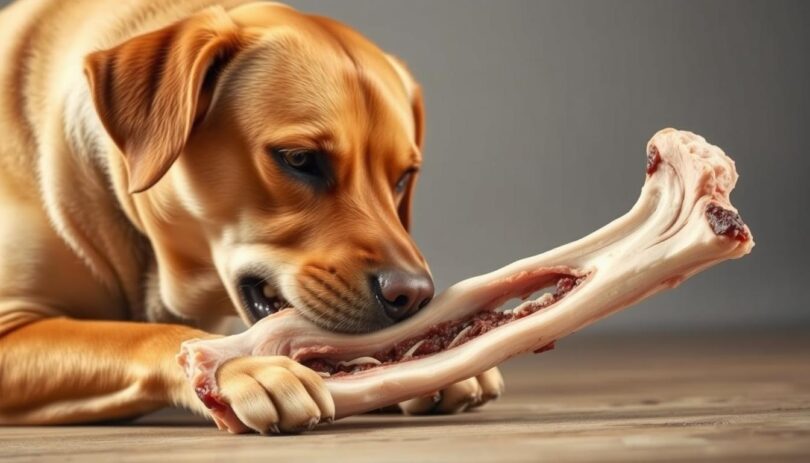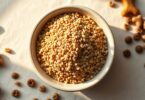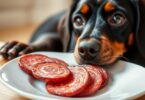Picture this: your furry companion gazes up at you, tail wagging, as you finish a meal. Those pleading eyes make it tempting to share a leftover treat. But when it comes to pork bones, hesitation creeps in. Are they a harmless reward or a hidden danger?
While chewing satisfies natural instincts, not all bones are created equal. Cooked varieties, for example, may splinter into sharp fragments. Raw options pose different challenges, from bacterial exposure to choking hazards. Size matters too—small pieces increase risks for intestinal blockages.
Nutritional benefits like calcium and mental stimulation exist, but precautions are non-negotiable. Preparation methods directly impact safety. Pet parents must weigh these factors carefully and consult veterinary professionals for personalized guidance.
This guide unpacks critical considerations, from fracture dangers to digestive complications. You’ll discover expert-backed strategies for minimizing threats while supporting your companion’s well-being. Let’s explore how to make informed choices that prioritize health without sacrificing tail-wagging joy.
Understanding Pork Bones in a Dog's Diet
Balancing nutrition and safety is key when considering alternative protein sources for pets. Pork offers essential amino acids and minerals that support muscle development and bone health. However, its role in meals requires careful evaluation of preparation methods and portion control.
Nutritional Value of Pork and Bones
High-quality cuts provide lean protein while raw varieties contain magnesium and phosphorus. These nutrients aid energy production and skeletal strength. Uncooked bones also supply calcium, which helps maintain strong teeth and joints.
Chewing activities naturally reduce plaque buildup. This promotes oral hygiene without artificial additives. Always ensure portions match the animal's size to prevent overconsumption.
Health Benefits and Potential Hazards
While nutrient-dense, raw options carry parasite risks like trichinella. Cooking eliminates pathogens but may create brittle fragments. Fatty trimmings should be removed to avoid pancreatitis triggers.
Consulting a veterinarian helps determine appropriate frequency. They can assess individual needs based on age, weight, and health history. Moderation remains crucial—supplementing regular meals rather than replacing them entirely.
Why Some Bones Are Off Limits for Dogs
Not all treats are created equal when it comes to canine safety. Size and preparation methods dramatically influence risk levels, turning innocent-looking snacks into potential emergencies.
Choking Hazards from Small Bones
Small or fragmented bones pose serious threats. Narrow fragments can become lodged in the throat, blocking airways. Even medium-sized breeds might struggle with a chop bone that suddenly gets stuck.
Supervision is critical during chewing sessions. Watch for frantic pawing at the mouth or gagging sounds—these signal immediate intervention is needed. Remove problematic pieces before they cause harm.
Cooked vs. Raw Bone Dangers
Heat transforms bone structure, making cooked pork bones brittle. Splintered edges may puncture soft tissues or create sharp pieces in the digestive tract. Raw bones, while less prone to breaking, still carry bacterial risks.
Veterinarians recommend selecting dense, uncut options for chewing. If a pet shows discomfort after gnawing—like drooling or refusing food—contact your vet without delay. Prevention beats emergency visits every time.
Can dogs have pork bones? Expert Insights
Veterinary professionals emphasize critical distinctions between bone types. While pets enjoy gnawing, safety depends on preparation and sourcing. Let’s explore expert perspectives on two common options.
Why Raw Options Raise Concerns
Raw pork bones carry dual threats: splintering and bacterial contamination. Despite their calcium content, sharp fragments can puncture intestines. Pathogens like Salmonella also linger on uncooked surfaces.
Dr. Emily Carter, a veterinary nutritionist, notes: “I’ve treated multiple cases of obstructions from raw rib bones. They’re unpredictable—even large breeds aren’t immune.” Always consult your vet before introducing these.
Smoked Varieties: A Safer Choice?
Slow-smoked pork bones undergo processing that reduces fracture risks. Brands like DuraChew Smoked Marrow Bones use controlled temperatures to maintain density while eliminating pathogens.
These products offer mental stimulation and protein without sharp edges. However, supervision remains essential. Rotate treats weekly to prevent dental fractures, and discard pieces smaller than a muzzle.
Ultimately, no bone is 100% risk-free. Reputable suppliers and vet guidance help balance enjoyment with safety. Prioritize products labeled “digestible” or “veterinary-approved” for peace of mind.
How To Safely Prepare Pork for Your Dog
Properly cooked pork can be a tasty and safe treat for pets when prepared with care. The secret lies in eliminating additives while preserving nutrients. Simple cooking techniques and vigilance about ingredients make all the difference.
Cooking Methods Without Harmful Seasonings
Boiling or baking plain pork retains protein without dangerous extras. Avoid oils, salts, and spices—even small amounts of onion or garlic powder can damage red blood cells. Use a meat thermometer to reach 145°F internally, then let it rest until hitting 165°F for safety.
Fat trimming is essential before cooking. Excess grease may trigger pancreatitis, especially in smaller breeds. Cut meat into pea-sized pieces for treats, never exceeding 10% of daily calories.
Portion control matters. A teaspoon of shredded cooked pork works for tiny companions, while larger pets might handle a tablespoon. Always supervise snack time and store leftovers properly.
Consult your veterinarian about dietary allergies first. Some animals react to novel proteins, so introduce new foods gradually. With these steps, you’ll create enjoyable moments that prioritize wellness.
Selecting Quality Pork Bones for Your Canine
Choosing the right pork bones for your furry friend starts at the source. Not all products meet safety standards, and quality directly impacts health outcomes. Prioritize suppliers who prioritize animal welfare and transparency.
Sourcing from Pastured Pigs
Pasture-raised pigs develop denser bones with higher mineral content. These animals graze on natural diets, reducing toxin buildup in their systems. Look for labels like “grass-fed” or “no antibiotics” at farmers' markets. Thick, smooth textures indicate better structural integrity for chewing.
Packaging should specify “human-grade” or “dog food approved.” Avoid bones with visible grease or artificial preservatives. Local butchers often provide details about farming practices—ask about feed sources and living conditions.
Identifying Factory-Farmed Risks
Mass-produced options frequently contain growth hormones and residual antibiotics. Thin, brittle bones from confined pigs splinter more easily. High-fat content in these products can trigger digestive issues or pancreatitis.
Check for certifications like USDA Organic or Global Animal Partnership. Steer clear of vague terms like “animal by-products” on ingredient lists. For safe bone options, review our guide to digestible treats that minimize choking hazards.
Create a selection checklist:
– Firm texture with minimal cracks
– Low marbling (visible fat)
– Transparent sourcing information
– Absence of chemical additives
Tips and Tricks for Giving Bones to Your Dog
Keeping your companion safe during bone-chewing sessions requires smart strategies. Thoughtful preparation and attentive care transform this natural activity into a rewarding experience while minimizing risks.
Proper Supervision and Bone Rotation
Always stay within arm’s reach when your pet enjoys a bone. Watch for aggressive gnawing or attempts to swallow large pieces. Replace worn-down items immediately—frayed edges increase fracture risks.
Rotate between dense marrow bones and softer cartilage options weekly. This approach maintains interest while reducing dental wear. Store unused treats in airtight containers to preserve freshness.
Recognizing Warning Signs and When to Consult a Vet
Excessive drooling or pawing at the mouth often indicates discomfort. Other red flags include vomiting, lethargy, or bloody stool. These symptoms may signal internal injuries requiring urgent care.
Contact your vet immediately if your pet shows distress after chewing. Emergency scenarios include choking attempts, refusal to eat, or visible bone fragments in vomit. Regular dental checks help spot hidden issues like cracked teeth early.
Remember: proactive monitoring prevents 90% of bone-related emergencies. Pair vigilance with scheduled vet visits to ensure long-term health and happiness.
Parting Words on Keeping Your Dog Safe
Protecting your companion starts with mindful choices and proactive habits. Focus on three pillars: safe preparation methods, vet-approved bone selection, and unwavering supervision during snack time. Each factor reduces risks while supporting natural chewing instincts.
Raw rib bones demand extreme caution due to bacterial threats, while smoked alternatives offer safer durability. Cooked versions should generally be avoided—their brittle texture often leads to dangerous splinters. Always source from reputable suppliers who prioritize animal welfare.
If offering pork-based treats, consult your vet about portion sizes and frequency. Watch for unusual behavior like excessive mouth irritation or digestive discomfort. Store emergency vet contacts prominently, and act swiftly if issues arise.
Remember: informed decisions create joyful moments. Pair vigilance with high-quality products tailored for canine needs. Your dedication ensures every wagging tail comes with peace of mind.
FAQ
Are pork bones beneficial for dogs?
Pork bones contain nutrients like calcium and phosphorus, which support dental health and joint function. However, their risks often outweigh benefits due to choking hazards or intestinal blockages. Always consult a veterinarian before introducing new items to your pet’s diet.
What makes cooked pork bones unsafe?
Cooking causes bones to dry out and splinter, creating sharp fragments that can puncture the digestive tract. Splintered pieces may also lodge in the throat or intestines, requiring emergency veterinary care. Stick to vet-approved chew toys for safer alternatives.
Can raw pork bones transmit diseases?
Raw pork carries bacteria like Salmonella or parasites such as Trichinella, which cause severe infections in pets. Freezing bones before feeding might reduce risk, but many veterinarians still discourage raw pork due to potential contamination.
Are smoked pork bones a safer alternative?
Smoked products often contain preservatives, excess salt, or artificial flavorings harmful to pets. Additionally, smoking doesn’t eliminate splintering risks. Opt for single-ingredient dental chews like Whimzees or Blue Buffalo Dental Bones instead.










Leave a Comment